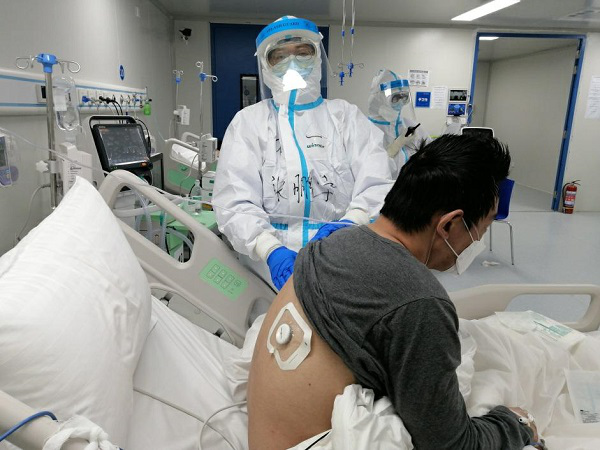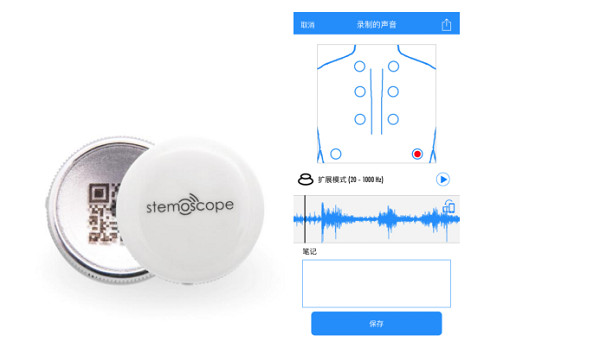- News
Shanghai Technology Enters into Leishenshan Hospital at the Fastest Speed, Medical Team from Shanghai General Hospital Takes the Lead to Apply 5G Wireless Stethoscope
Source: Xinmin Evening News Author: Zuo Yan Correspondent Hu Yang

medical team from Shanghai General Hospital treats patients with "5g wireless Stethoscope", the picture is provided by the interviewees (the same below)
Pulmonary inflammation in pneumonia patients is the most important factor to determine the outcome of the disease, while the stethoscope plays a key role. The medical team from Shanghai General Hospital applied a new equipment -“5G wireless Stethoscope" to monitor the change of patients' condition in the cabin of Leishenshan (Thunder God Mountain) hospital. The device small in size and easy to disinfect was jointly developed by cardiology department, respiratory department of Shanghai General Hospital and medical workers from Shanghai Jiaotong University. It can continuously collect auscultation sounds. Besides listening to breath sounds, it can also be used to listen to heart sounds, identify the position of nasogastric tube, etc. to help medical staff judge the patient's condition in real time. The medical team can also transmit the data to the hospital to achieve tele-consultation through the 5G tele-consultation platform.
"This patient has a wide range of wheezing sounds and may have airway spasm. Can we add a little hormone and then some antispasmodic drugs?" In the treatment cabin of Wuhan Leishenshan hospital, Zhang Pengyu, chief physician of respiratory department of Shanghai General Hospital was listening to the breath sound of a severe patient just collected on the mobile phone. Not long ago, the patient's condition suddenly worsened and the oxygen saturation plummeted. It was very difficult to carry out CT examination because of the inability to stop the high flow of oxygen. Zhang Pengyu fixed 5g wireless stethoscope on the back of the patient with medical tape, and quickly collected clear breath sounds. After the symptomatic treatment, the patient recovered.
"Most of the patients in the ICU are in the state of endotracheal intubation, which can not be separated from high flow oxygen inhalation. It is difficult to carry out CT examination, but it is a simple and effective method to monitor the condition of the patients' lungs through auscultation." Zhang Pengyu told the journalist, "the traditional stethoscope can't be used after wearing protective equipment, so we prepared this device. At present, the effect is very good. Both wheezing sound and phlegm sound can be heard. Before that, a patient suffered from sudden oxygen saturation drop. A large number of existing phlegm sounds can be heard through auscultation, and the danger is relieved after sputum suction treatment in time."

5G wireless stethoscope
In addition to auscultation during emergency treatment, "5G wireless stethoscope" can also auscultate and follow up patients during daily rounds. During the check-up, experts from Shanghai General Hospital found that although the chest CT image of some patients had little change, the rale of the lung basically disappeared, suggesting that the functional change of the lung may be earlier than the organic change in the rehabilitation process. After fully verification, such patients can be transferred out of the ICU and into the general ward earlier. In addition, the medical team also uses wireless stethoscope to treat patients with myocardial infarction, and correct heart failure through auscultation of heart sound. It can also identify the correct position of the nasogastric tube, prevent and treat aspiration pneumonia, etc.
Liu Jun, the team leader and vice president of Shanghai General Hospital told journalist that the medical team can transmit real-time data to the hospital through 5G tele-consultation platform, so that the specialists can consult and diagnose the disease at any time. In the future, the hospital also plans to upgrade the recognition of breath sounds to intelligent automation through the in-depth learning technology of artificial intelligence, so as to realize the real-time monitoring of patients.
Zhu Yanhong, director of the scientific research department of Shanghai General Hospital told the journalist since the establishment of the hospital's Clinical Research Institute in 2019, a series of preliminary work and clinical trials have been completed on the platform of medical artificial intelligence and medical engineering cross research and development center. The prototype of this product comes from the cooperation between Zhang Zhi, deputy director of cardiology department and an institution. After the outbreak of COVID-19, the R & D team seized the clinical needs and worked with Shanghai Jiao Tong University to work overtime and upgrade the products and software. Finally, the first batch of products was handed over to the medical team experts before the eighth batch of medical teams headed for Wuhan.
